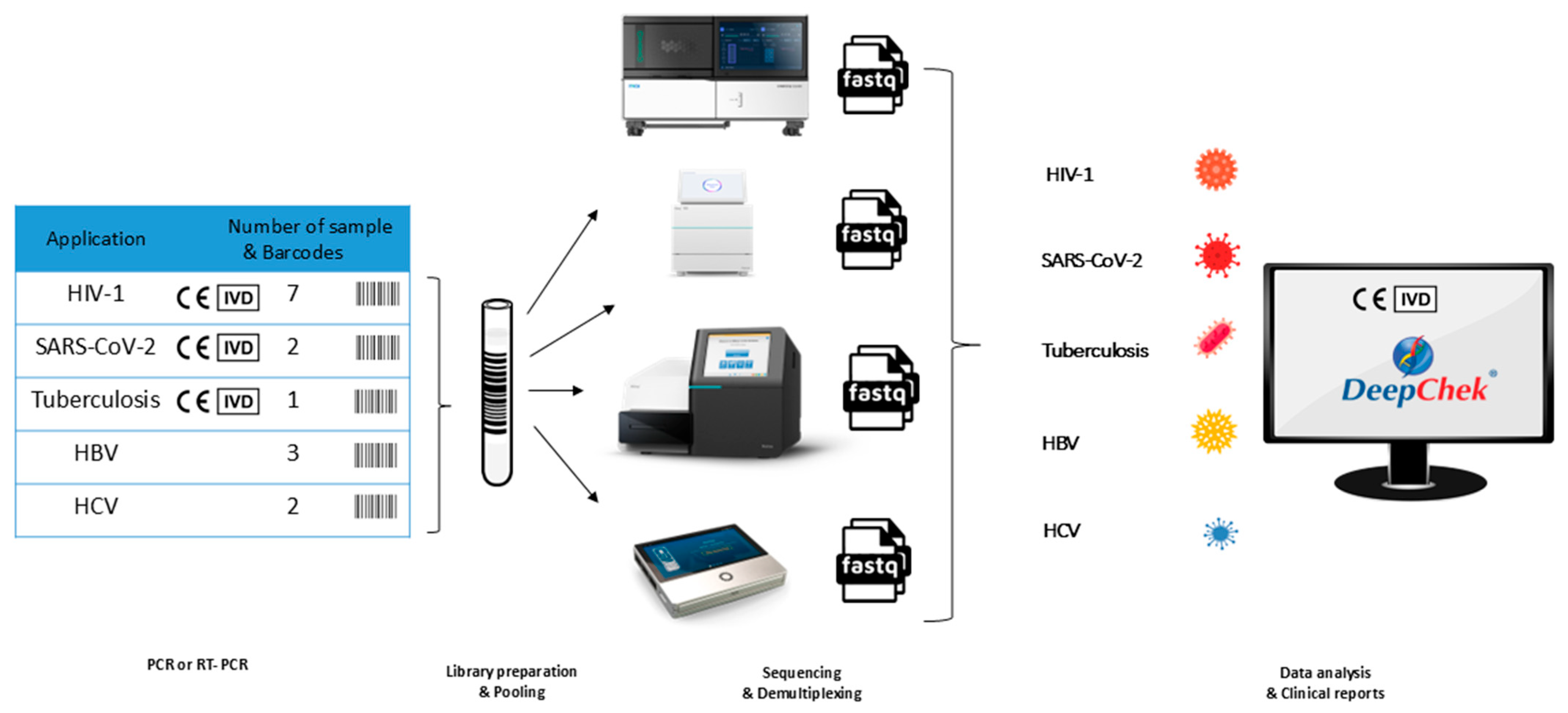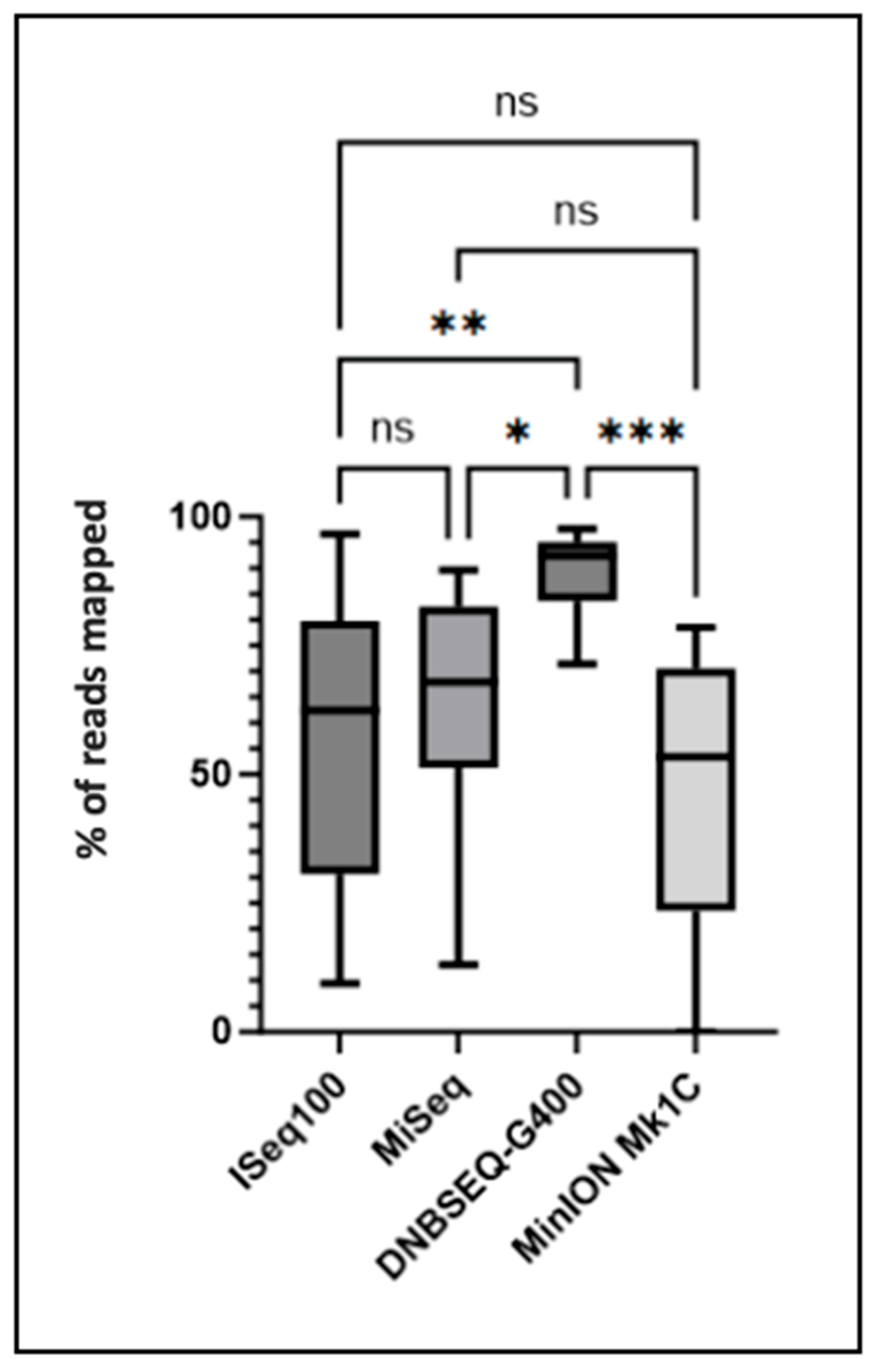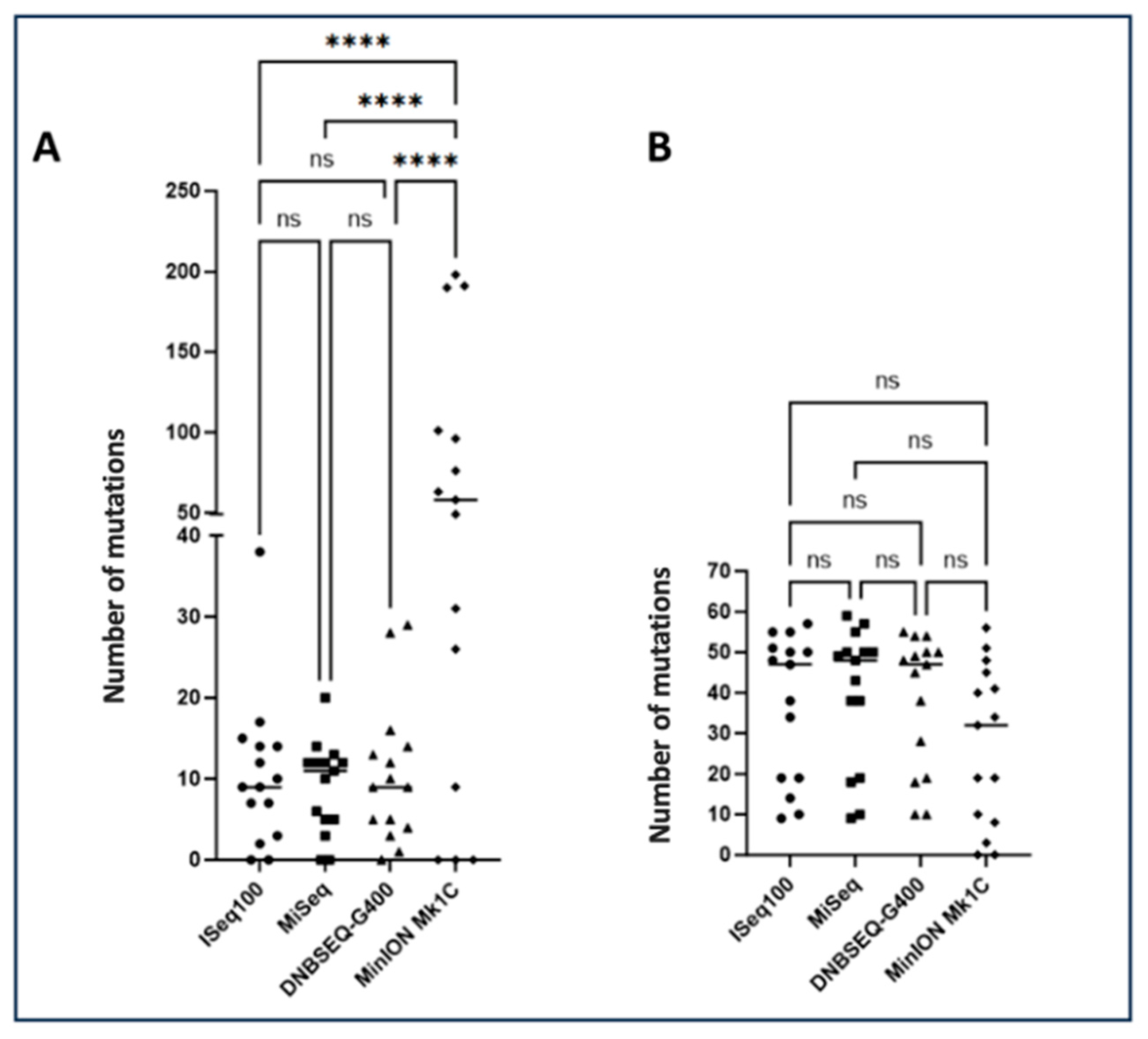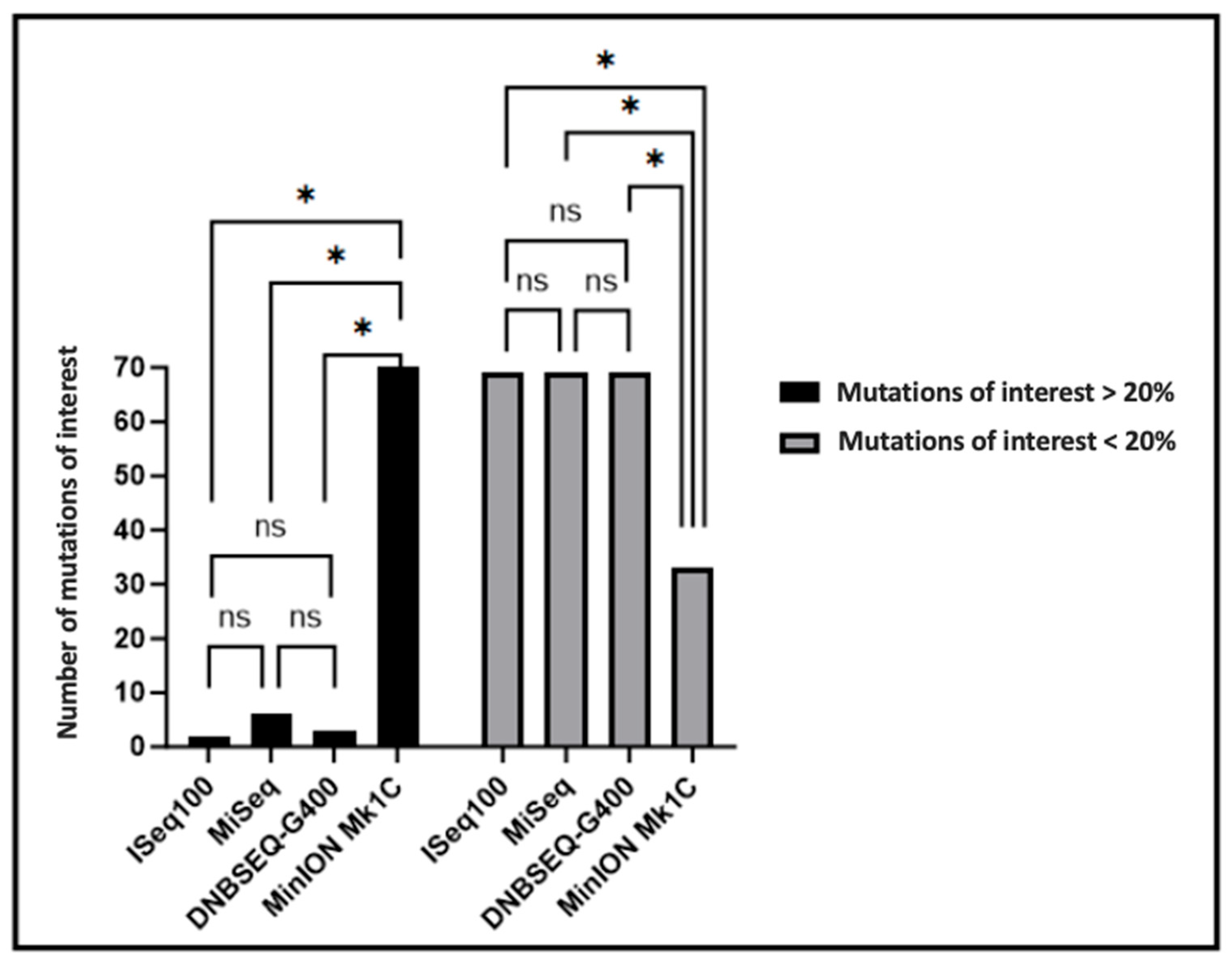Advancing Drug Resistance Detection: Comparative Analysis Using Short-Read and Long-Read Next-Generation Sequencing Technologies
Abstract
1. Background
2. Study Design
2.1. Samples
2.2. Extraction of Viral DNA/RNA
2.3. Amplification of Target Regions by RT-PCR and PCR
2.4. Illumina Sequencing
2.5. Nanopore Sequencing
2.6. MGI Sequencing
2.7. Data Analysis and Interpretation of Results
2.8. Statistical Tests
3. Results
3.1. Sequencing Quality Control
3.2. Global Comparative Analysis Between Different Platforms
3.3. Comparative Analysis of Mutations Detected Using DeepChek® Software
4. Discussion
4.1. Mutations and Detection of New Variants
4.2. Resistance and Treatment
4.3. NGS Short Reads
4.4. NGS Long Reads
4.5. Benefits of Microbiological Pooling
4.6. Clinical Relevance of Detecting Minority Variants:
5. Conclusions
Supplementary Materials
Author Contributions
Funding
Institutional Review Board Statement
Informed Consent Statement
Data Availability Statement
Conflicts of Interest
Abbreviations
| ABL | Advanced Biological Laboratories |
| AIDS | Acquired Immune Deficiency Syndrome |
| ANOVA | Analysis of Variance |
| ANRS | French National Agency for Research on AIDS and Viral Hepatitis |
| ARV | Antiretroviral |
| ATV | Antiviral |
| Bp | Base pair |
| DNA | Deoxyribonucleic Acid |
| DNB | DNA NanoBall |
| DRMs | Drug resistance mutations |
| Go | Giga |
| HBV | Hepatitis B virus (HBV) |
| HCV | Hepatitis C virus |
| HIV | Human immunodeficiency virus (HIV) |
| HIVDb | HIV Drug Resistance Database |
| INT | Inteegrase |
| MGI | Medical Genomics Instruments (MGI) |
| NGS | Next-Generation Sequencing |
| NRTI | Nucleoside Reverse Transcriptase Inhibitors |
| NNRTI | Non Nucleoside Reverse Transcriptase Inhibitors |
| NS3 | Non Structural Protein 3 |
| NS5A | Non Structural Protein 5A |
| NS5B | Non Structural Protein 5B |
| PCR | Polymerase chain reaction |
| PR | Protease |
| QCMD | Quality Control for Molecular Diagnostics |
| RCA | Rolling circle amplification |
| RNA | Ribonucleic Acid |
| RT | Reverse Transcriptase |
| RT-PCR | Reverse Transcription Polymerase Chain Reaction |
| SC2 | SARS-CoV-2 |
| TB | Mycobacterium tuberculosis |
References
- Agbota, G.; Bonnet, M.; Lienhardt, C. Perspectives d’élimination de La Tuberculose: La Stratégie OMS à l’épreuve de La Pandémie de COVID-19. Médecine Mal. Infect. Form. 2022, 1, 62–68. [Google Scholar] [CrossRef]
- Colin, L. Impact de L’arrêt de Médicaments Antirétroviraux Concernés par la Résistance Virale à la Lumière des Données de L’algorithme D’interprétation le Plus Récent. Master’s Thesis, Paris Descartes University, Paris, France, 2018. [Google Scholar]
- Domingo, E.; Perales, C. Viral Quasispecies. PLoS Genet. 2019, 15, e1008271. [Google Scholar] [CrossRef] [PubMed]
- Mohamed, S.; Penaranda, G.; Gonzalez, D.; Camus, C.; Khiri, H.; Boulmé, R.; Sayada, C.; Philibert, P.; Olive, D.; Halfon, P. Comparison of Ultra-Deep versus Sanger Sequencing Detection of Minority Mutations on the HIV-1 Drug Resistance Interpretations after Virological Failure. AIDS 2014, 28, 1315. [Google Scholar] [CrossRef] [PubMed]
- Blanc, A.; Bonnet, F.; Brun-Vezinet, F.; Costagliola, D.; Dabis, F.; Delobel, P.; Faye, A.; Fischer, H.; Goujard, C.; Guillon, M.; et al. Recommendations of the Expert Group for the Management of HIV. National Council on AIDS and Viral Hepatitis (CNS). 2016. Available online: https://cns.sante.fr/sites/cns-sante/files/2017/02/experts-vih_resistance.pdf (accessed on 11 April 2025).
- Kim, H.-M.; Jeon, S.; Chung, O.; Jun, J.H.; Kim, H.-S.; Blazyte, A.; Lee, H.-Y.; Yu, Y.; Cho, Y.S.; Bolser, D.M.; et al. Comparative Analysis of 7 Short-Read Sequencing Platforms Using the Korean Reference Genome: MGI and Illumina Sequencing Benchmark for Whole-Genome Sequencing. Gigascience 2021, 10, giab014. [Google Scholar] [CrossRef] [PubMed]
- Rang, F.J.; Kloosterman, W.P.; de Ridder, J. From Squiggle to Basepair: Computational Approaches for Improving Nanopore Sequencing Read Accuracy. Genome Biol. 2018, 19, 90. [Google Scholar] [CrossRef] [PubMed]
- Mohamed, S.; Boulmé, R.; Sayada, C. From Capillary Electrophoresis to Deep Sequencing: An Improved HIV-1 Drug Resistance Assessment Solution Using In Vitro Diagnostic (IVD) Assays and Software. Viruses 2023, 15, 571. [Google Scholar] [CrossRef] [PubMed]
- Tambuyzer, L.; Azijn, H.; Rimsky, L.T.; Vingerhoets, J.; Lecocq, P.; Kraus, G.; Picchio, G.; de Béthune, M.-P. Compilation and Prevalence of Mutations Associated with Resistance to Non-Nucleoside Reverse Transcriptase Inhibitors. Antivir. Ther. 2009, 14, 103–109. [Google Scholar] [CrossRef] [PubMed]
- Salamon, D.; Zapała, B.; Krawczyk, A.; Potasiewicz, A.; Nikiforuk, A.; Stój, A.; Gosiewski, T. Comparison of iSeq and MiSeq as the Two Platforms for 16S rRNA Sequencing in the Study of the Gut of Rat Microbiome. Appl. Microbiol. Biotechnol. 2022, 106, 7671–7681. [Google Scholar] [CrossRef] [PubMed]
- Laver, T.; Harrison, J.; O’Neill, P.A.; Moore, K.; Farbos, A.; Paszkiewicz, K.; Studholme, D.J. Assessing the Performance of the Oxford Nanopore Technologies MinION. Biomol. Detect. Quantif. 2015, 3, 1–8. [Google Scholar] [CrossRef] [PubMed]
- Kono, N.; Arakawa, K. Nanopore Sequencing: Review of Potential Applications in Functional Genomics. Dev. Growth Differ. 2019, 61, 316–326. [Google Scholar] [CrossRef] [PubMed]
- Wang, Y.; Zhao, Y.; Bollas, A.; Wang, Y.; Au, K.F. Nanopore Sequencing Technology, Bioinformatics and Applications. Nat. Biotechnol. 2021, 39, 1348–1365. [Google Scholar] [CrossRef] [PubMed]
- Teufel, M.; Sobetzko, P. Reducing Costs for DNA and RNA Sequencing by Sample Pooling Using a Metagenomic Approach. BMC Genom. 2022, 23, 613. [Google Scholar] [CrossRef] [PubMed]
- Takele Assefa, A.; Vandesompele, J.; Thas, O. On the Utility of RNA Sample Pooling to Optimize Cost and Statistical Power in RNA Sequencing Experiments. BMC Genom. 2020, 21, 312. [Google Scholar] [CrossRef] [PubMed]




| Sample ID | Pathogen | Target | Viral Load or Concentration |
|---|---|---|---|
| 1 | HIV | Reverse Transcriptase/Protease/Integrase | 13,346 copies/mL |
| 2 | HIV | Reverse Transcriptase/Protease/Integrase | 70,000 copies/mL |
| 3 | HIV | Reverse Transcriptase/Protease/Integrase | 200,000 copies/mL |
| 4 | HIV | Reverse Transcriptase/Protease/Integrase | 15,000 copies/mL |
| 5 | HIV | Reverse Transcriptase/Protease/Integrase | 100,000 copies/mL |
| 6 | HIV | Reverse Transcriptase/Protease/Integrase | 25,000 copies/mL |
| 7 | HIV | Reverse Transcriptase/Protease/Integrase | 50,000 copies/mL |
| 8 | HBV | Whole genome | >1,000,000 copies/mL |
| 9 | HBV | Whole genome | >1,000,000 copies/mL |
| 10 | HBV | Whole genome | >1,000,000 copies/mL |
| 11 | HCV | NS3/NS5A/NS5B/Core | NA |
| 12 | HCV | NS3/NS5A/NS5B/Core | NA |
| 13 | SC2 | Whole genome | 3.89 × 103 TCID50/mL |
| 14 | SC2 | Whole genome | 3.89 × 101 TCID50/mL |
| 15 | TB | 13plex | 2.3 × 108 CFU/mL |
| HIV | RT: 1165 bp | PR: 645 bp | INT: 720 bp | ||
| HBV | Fragment 1: 1460 bp | Fragment 2: 829 bp | Fragment 3: 1208 bp | ||
| HCV | NS5A: 817 bp | NS5B Fragment A: 1048 bp | NS5B Fragment B nested: 749 bp | NS3: 776 bp | Core : 463 bp |
| SC2 | Pool 1: 400 bp | Pool 2: 400 bp | |||
| TB | 13Plex: Between 480 and 1350 bp |
| Pathogen | Algorithms | Algorithm Used for Classification of Mutation of Interest |
|---|---|---|
| HIV-1 | ANRS (33 10-2022) Grade (2021 9-2021) HIVDb (9.4 12-2022) | ANRS33 |
| HCV | Geno2Pheno (0.92-12-2017 12-2017) International Antiviral Society (2013 01-2013) Lontok et al. Hepatology 2025 (1.0 06-2015) Sorbo (1.0 2018) | Geno2Pheno 0.92-12-2017 |
| HBC | Geno2Pheno (2.0 2009) Grade (2007 08/2007) SeqHepB (6 November 2016) | SeqHepB 6 |
| Mycobacterium tuberculosis (TB) | DeepChek® 13-Plex KB Drug Susceptibility Testing (v2022-09 23-09-2022) 03-2018 literature review (03-2018) PhyResSE (v29 2019) ReSeq TB (v2019-01 01-2019) WHO Catalog of mutations (v2021-06 25-06-2021) | WHO Catalog of mutations v2021-06 |
| ISeq100 | MiSeq | DNBSEQ-G400 | Mk1C MinION | |
|---|---|---|---|---|
| Q30 (%) | 83.03 | 93 | 95.68 | NA |
| Density (%) | 82 | 88 | 77 | NA |
| Number of reads (M) | 4.5 | 16 | 115 | 3.8 |
| Size of data generated (Mo) | 30 | 120 | 520 | 140 |
| Pathogen | Sample ID | Minority Mutations of Interest (>1% to <20%) | Majority Mutations of Interest (>20% to <100%) | ||||||
| ISeq100 | MiSeq | DNBSEQ-G400 | Mk1C | ISeq100 | MiSeq | DNBSEQ-G400 | Mk1C | ||
| HIV | 1 | T66K (5.78%), L74M (6.77%), Y143S (4.56%), Q148H (9.00%), V151L (7.42%), S153F/Y (6.32%), S230R (8.70%) | T66K (4.88%), L74M (5.71%), Y143S (4.28%), Q148H (8.19%), V151L (5.42%), S153F/Y (4.33%), S230R (9.47%) | T66K (3.98%), L74M (7.01%), Y143S (3.33%), Q148H (9.80%), V151L (6.30%), S153F/Y (5.33%), S230R (10.26%) | K65R (3%), K103R (4.7%), F53L (4.65%), I54L (3.22%), N88S (3.45%) | L63P | L63P | L63P | L63P |
| 2 | E44D (7.30%), T69S (5.98%) | E44D (6.02%), T69S (6.94%) | E44D (5.89%), T69S (5.30%) | K65E (6.87%), L100I (15.19%), K103R (3.51%) | A71T | A71T | A71T | A71T | |
| 3 | none | none | none | none | none | none | none | none | |
| 4 | none | none | none | F53L (3.04%) | V179I | V179I | V179I | V179I | |
| 5 | none | none | none | none | M41L, E44D, D67N, T69D, A98G, M184I, Y188L, G190A, L210W, T215Y, K20R, L63P | M41L, E44D, D67N, T69D, A98G, M184I, Y188L, G190A, L210W, T215Y, K20R, L63P | M41L, E44D, D67N, T69D, A98G, M184I, Y188L, G190A, L210W, T215Y, K20R, L63P | M41L, E44D, D67N, T69D, A98G, M184I, Y188L, G190A, L210W, T215Y, K20R, L63P | |
| 6 | none | none | none | K65E (7.52%), K103R (3.65%) | M41L, M184V, L210W, T215Y | M41L, M184V, L210W, T215Y | M41L, M184V, L210W, T215Y | M41L, M184V, L210W, T215Y | |
| 7 | V32I (3.22%) | V32I (3.22%) | none | K65R (3.75%), M184I (3.09%), F53L (3.68%) | M184V, G16E, K20R, M46I, I54V, V82A | M184V, G16E, K20R, M46I, I54V, V82A | M184V, G16E, K20R, M46I, I54V, V82A | M184V, G16E, K20R, M46I, I54V, V82A | |
| HBV | 8 | none | none | none | none | none | none | none | none |
| 9 | P120T (4.76%) | P120T (5.35%) | P120T (5.35%) | P120T (4.89%) | none | none | none | none | |
| 10 | none | none | none | P127S (3.08%), T131N (3.11%) | none | none | none | none | |
| HCV | 11 | none | none | none | none | none | none | none | none |
| 12 | none | none | none | V36A (4.98%), L31I (3.94%) | R117H | R117H | R117H | R117H | |
| TB | 15 | none | none | none | none | c-15t, S315T, S450L, H71R, K88R, D94Y, g944c, c1349t, Y334H, t1000c, H71R, a212g, a263g, g280t | c-15t, S315T, S450L, H71R, K88R, D94Y, g944c, c1349t, Y334H, t1000c, H71R, a212g, a263g, g280t | c-15t, S315T, S450L, H71R, K88R, D94Y, g944c, c1349t, Y334H, t1000c, H71R, a212g, a263g, g280t | c-15t, S315T, S450L, H71R, K88R, D94Y, g944c, c1349t, Y334H, t1000c, H71R, a212g, a263g, g280t |
| PATHOGEN | SAMPLE ID | ISEQ 100 | MISEQ | DNBSEQ-G400 | MK1C | ISEQ 100 | MISEQ | DNBSEQ-G400 | MK1C | ISEQ 100 | MISEQ | DNBSEQ -G400 | MK1C | ISEQ 100 | MISEQ | DNBSEQ -G400 | MK1C |
| Target | NRTI | NNRTI | PR | INT | |||||||||||||
| HIV | 1 | * | * | * | * | ||||||||||||
| 2 | |||||||||||||||||
| 3 | |||||||||||||||||
| 4 | |||||||||||||||||
| 5 | 20% | 20% | 20% | 20% | 20% | 20% | 20% | 20% | |||||||||
| 6 | 20% | 20% | 20% | 20% | |||||||||||||
| 7 | 20% | 20% | 20% | 20% | 20% | 20% | 20% | 20% | |||||||||
| Target | Inhibitors of RT | ||||||||||||||||
| HBV | 8 | ||||||||||||||||
| 9 | |||||||||||||||||
| 10 | |||||||||||||||||
| Target | NS3 | NS5A | NS5B | ||||||||||||||
| HCV | 11 | * | * | * | * | * | * | ||||||||||
| 12 | 20% | 20% | 20% | 20% | |||||||||||||
| Target | Inhibitors of drugs | ||||||||||||||||
| TB | 15 | 20% | 20% | 20% | 20% | ||||||||||||
| Sample ID | ISeq100 | MiSeq | DNBSEQ-G400 | Mk1C |
| 1 | C | C | C | C |
| 2 | 02-AG/0206 | 02-AG/0206 | 02-AG/0206 | 02-AG/0206 |
| 3 | B | B | B | B |
| 4 | 02-AG | 02-AG | 02-AG | 02-AG |
| 5 | 31_BC | 31_BC | 31_BC | 31_BC |
| 6 | B | B | B | B |
| 7 | C | C | C | C |
| 8 | B | B | B | B |
| 9 | B/C | B/C | B/C | B/C |
| 10 | B | B | B | B |
| 11 | 1b | 1b | 1b | 1b |
| 12 | 1b | 1b | 1b | 1b |
| 13 | Omicron lineage.1.1.529 | Omicron lineage.1.1.529 | Omicron lineage.1.1.529 | Omicron lineage.1.1.529 |
| 14 | Omicron lineage.1.1.529 | Omicron lineage.1.1.529 | Omicron lineage.1.1.529 | Omicron lineage.1.1.529 |
| 15 | Mycobacterium tuberculosis | Mycobacterium tuberculosis | Mycobacterium tuberculosis | Mycobacterium tuberculosis |
| Evaluation Point | MGI G400 | Illumina iSeq 100 | Illumina MiSeq | Nanopore MinION |
|---|---|---|---|---|
| Read type | Short-read (PE100/150) | Short-read (PE150) | Short-read (PE150/250/300) | Long-read (variable) |
| Read accuracy | High (>99.9%) | Good (~99.5%) | Very good (>99.7%) | Moderate (~90–95% raw) |
| Data output per run | High (up to 144 Gb) | Low (~1–2 Gb) | Medium (~15–20 Gb) | Variable (~1–10 Gb) |
| Library preparation time | ~ 4–5 h | ~ 2–4 h | ~ 2–5 h | ~ 1–2 h |
| Cost per sample | Cost-effective | High | Moderate | Low to moderate |
| Sequencing time | Medium (~24 h) | Fast (~19 h) | Medium (~24–36 h) | Fast (~2–12 h) |
| DeepChek® Software | Yes | Yes | Yes | Yes |
| DeepChek® Library preparation kit | Yes | Yes | Yes | Limited |
| Infrastructure requirements | Moderate to high | Low | Low to moderate | Minimal |
| Resistance Applications | Recommended (High read depth and accuracy) | Recommended (Suitable for smaller panels) | Recommended (Gold standard in clinical diagnostics) | Recommended (a validated frequency cutoff must be applied) |
Disclaimer/Publisher’s Note: The statements, opinions and data contained in all publications are solely those of the individual author(s) and contributor(s) and not of MDPI and/or the editor(s). MDPI and/or the editor(s) disclaim responsibility for any injury to people or property resulting from any ideas, methods, instructions or products referred to in the content. |
© 2025 by the authors. Licensee MDPI, Basel, Switzerland. This article is an open access article distributed under the terms and conditions of the Creative Commons Attribution (CC BY) license (https://creativecommons.org/licenses/by/4.0/).
Share and Cite
Martinez, J.; Drali, R.; Doudou, A.; Sayada, C.; Boulmé, R.; Gonzalez, D.; Deblir, L.; Barralon, M.; Wautrin, J.; Porzio, J.; et al. Advancing Drug Resistance Detection: Comparative Analysis Using Short-Read and Long-Read Next-Generation Sequencing Technologies. LabMed 2025, 2, 14. https://doi.org/10.3390/labmed2030014
Martinez J, Drali R, Doudou A, Sayada C, Boulmé R, Gonzalez D, Deblir L, Barralon M, Wautrin J, Porzio J, et al. Advancing Drug Resistance Detection: Comparative Analysis Using Short-Read and Long-Read Next-Generation Sequencing Technologies. LabMed. 2025; 2(3):14. https://doi.org/10.3390/labmed2030014
Chicago/Turabian StyleMartinez, Julie, Rezak Drali, Amira Doudou, Chalom Sayada, Ronan Boulmé, Dimitri Gonzalez, Laurent Deblir, Matthieu Barralon, Jérome Wautrin, Jonathan Porzio, and et al. 2025. "Advancing Drug Resistance Detection: Comparative Analysis Using Short-Read and Long-Read Next-Generation Sequencing Technologies" LabMed 2, no. 3: 14. https://doi.org/10.3390/labmed2030014
APA StyleMartinez, J., Drali, R., Doudou, A., Sayada, C., Boulmé, R., Gonzalez, D., Deblir, L., Barralon, M., Wautrin, J., Porzio, J., Reffay, A., Errafyqy, M., Kolsch, J., Léonard, J., Zuco, G., Modol, A., & Mohamed, S. (2025). Advancing Drug Resistance Detection: Comparative Analysis Using Short-Read and Long-Read Next-Generation Sequencing Technologies. LabMed, 2(3), 14. https://doi.org/10.3390/labmed2030014







